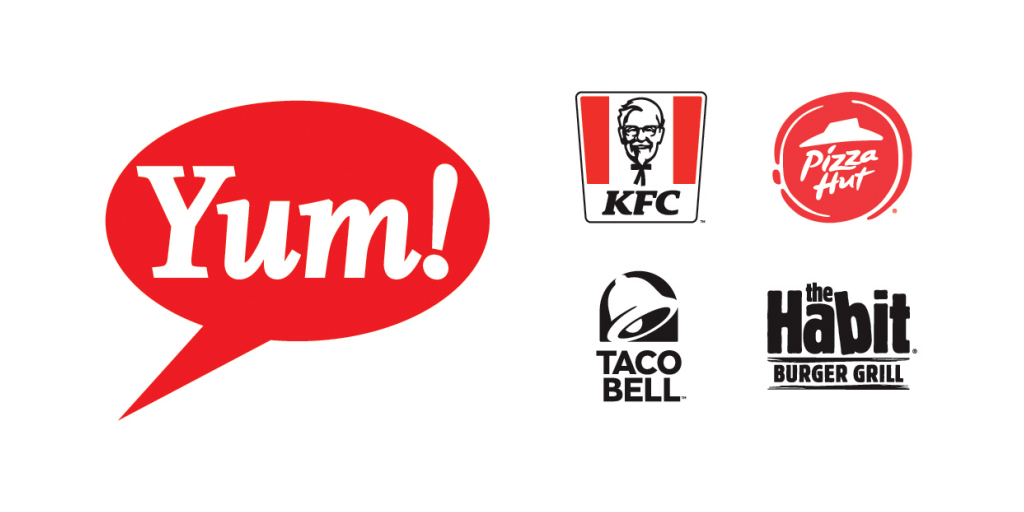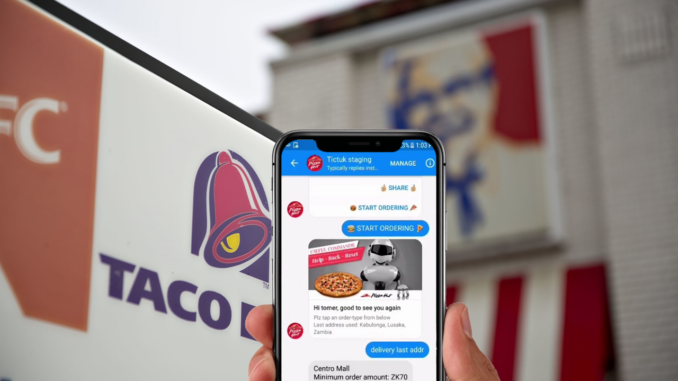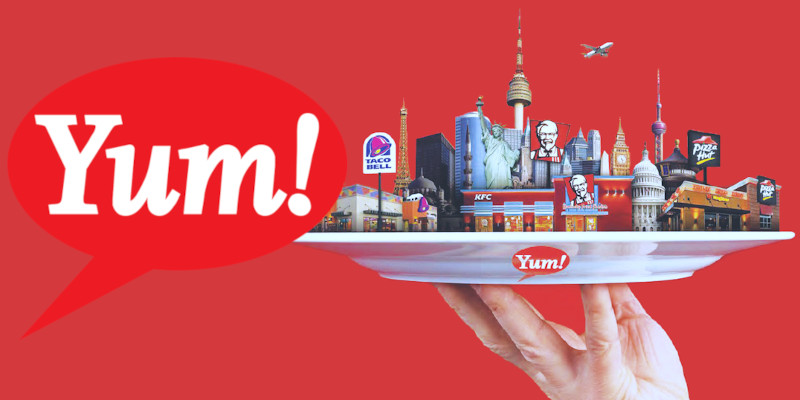Yum! Brands, Inc. is a global quick-service restaurant company that owns and franchises four restaurant brands: KFC, Pizza Hut, Taco Bell, and The Habit Burger Grill. The company was founded in 1997 as a spin-off of PepsiCo, and it is now the world’s largest restaurant company by system units, with over 55,000 restaurants in more than 155 countries and territories.

Yum! Brands’ four restaurant brands are all leaders in their respective categories. KFC is the world’s largest chicken restaurant chain, with over 25,000 restaurants worldwide. Pizza Hut is the world’s largest pizza restaurant chain, with over 18,000 restaurants worldwide. Taco Bell is the world’s largest Mexican-style fast food restaurant chain, with over 7,500 restaurants worldwide. The Habit Burger Grill is a fast-casual restaurant chain with over 350 restaurants in the United States.
Yum! Brands’ success is due in part to its strong global presence. The company has a significant presence in both developed and emerging markets. In developed markets, such as the United States and Europe, Yum! Brands’ restaurants are well-established and have a strong brand recognition. In emerging markets, such as China and India, Yum! Brands is growing rapidly and is gaining market share.
Another factor in Yum! Brands’ success is its focus on innovation. The company is constantly developing new products and services to meet the needs of its customers. For example, in recent years, Yum! Brands has introduced new menu items, such as the KFC Double Down sandwich and the Taco Bell Doritos Locos Tacos. The company has also expanded its digital offerings, such as online ordering and delivery.
Yum! Brands is also committed to social responsibility. The company has a number of programs in place to support its employees, communities, and the environment. For example, Yum! Brands has a program called the Yum! Global Restaurant Initiative, which provides training and support to small businesses in developing countries. The company also has a number of sustainability initiatives in place, such as reducing its energy consumption and waste production.
Yum! Brands’ Four Restaurant Brands
KFC

KFC is the world’s largest chicken restaurant chain, with over 25,000 restaurants in more than 145 countries and territories. KFC is known for its fried chicken, which is made using a secret recipe that was developed by Colonel Harland Sanders in the 1950s. In addition to fried chicken, KFC also offers a variety of other chicken products, such as chicken strips, chicken sandwiches, and chicken wraps.
Pizza Hut

Pizza Hut is the world’s largest pizza restaurant chain, with over 18,000 restaurants in more than 100 countries and territories. Pizza Hut is known for its pan pizzas, which are made with a thick crust and a generous amount of toppings. In addition to pan pizzas, Pizza Hut also offers a variety of other pizzas, such as thin crust pizzas, stuffed crust pizzas, and hand-tossed pizzas.
Taco Bell

Taco Bell is the world’s largest Mexican-style fast food restaurant chain, with over 7,500 restaurants in more than 30 countries and territories. Taco Bell is known for its tacos, burritos, nachos, and quesadillas. The company also offers a variety of other Mexican-style food items, such as chalupas, gorditas, and tostadas.
The Habit Burger Grill

The Habit Burger Grill is a fast-casual restaurant chain with over 350 restaurants in the United States. The Habit Burger Grill is known for its charbroiled burgers, which are made with fresh, never-frozen beef. In addition to burgers, The Habit Burger Grill also offers a variety of other sandwiches, salads, and sides.
Marketing Strategies of Yum! Brands
Yum! Brands is a global fast-food conglomerate known for its iconic restaurant brands, including KFC, Pizza Hut, Taco Bell, and The Habit Burger Grill. To maintain its competitive edge and global presence, Yum! Brands employs a range of marketing strategies. Let’s delve into these strategies in detail:
1. Brand Diversification
Yum! Brands has successfully implemented brand diversification through its acquisition and development of multiple brands. For instance, the company acquired Pizza Hut in 1973, KFC in 1986, and Taco Bell in 1991. Each brand caters to a distinct segment of the fast-food market, with KFC focusing on fried chicken, Pizza Hut offering various pizza options, and Taco Bell specializing in Mexican-inspired cuisine. Moreover, Yum! Brands has introduced new brands, such as WingStreet and Pasta Hut, to further diversify its portfolio and penetrate new markets.
The benefits of brand diversification are evident in Yum! Brands’ financial performance. Despite facing challenges in recent years, including intense competition and shifting consumer preferences, the company’s diversified portfolio has helped maintain steady growth. In 2020, Yum! Brands reported a net income of $1.5 billion, with KFC, Pizza Hut, and Taco Bell contributing significantly to the company’s profitability. Effective brand diversification has enabled Yum! Brands to adapt to changing market conditions, minimize risks, and continue to thrive in the fast-food industry.
2. Global Presence
Global presence is a marketing strategy that Yum! Brands has effectively utilized to expand its reach and grow its customer base. The company has established a strong presence in over 155 countries and territories worldwide, with a total of over 55,000 restaurants across its brands. This widespread presence allows Yum! Brands to tap into diverse markets and cultures, tailoring its menu offerings and marketing approaches to suit local tastes and preferences.

One of the key factors contributing to Yum! Brands’ success in global expansion is its ability to adapt to local markets. The company has developed region-specific menu items and marketing campaigns that resonate with local consumers. For instance, in China, KFC offers a variety of rice dishes and spicy menu items that cater to Chinese taste buds, while in India, Pizza Hut has introduced a vegetarian pizza option to accommodate local dietary preferences. By customizing its approach to each market, Yum! Brands has been able to establish a strong foothold in regions with diverse cultural and culinary backgrounds.
The benefits of Yum! Brands’ global presence are multifaceted. Firstly, it allows the company to capitalize on the growing demand for fast food in emerging markets, where there is an increasing appetite for Western-style food. Secondly, it provides a hedge against economic uncertainty in individual markets, as performance in one region can offset weakness in another. Finally, a strong global presence enhances Yum! Brands’ brand recognition and reputation, making it an attractive choice for franchisees and customers alike. The company’s successful implementation of this strategy has contributed significantly to its long-term growth and profitability.
3. Digital and Technology Integration
Digital and technology integration is a marketing strategy that Yum! Brands has embraced to enhance its customer experience, improve operational efficiency, and drive sales. The company has leveraged digital technologies such as mobile apps, social media, and data analytics to create personalized experiences for its customers and stay ahead of the competition.
Yum! Brands has developed mobile apps for its KFC, Pizza Hut, and Taco Bell brands, allowing customers to place orders, pay, and track their delivery status conveniently. The apps also provide personalized recommendations based on users’ previous orders and preferences, encouraging repeat purchases and enhancing customer satisfaction. Furthermore, the company has integrated social media into its marketing strategy, using platforms like Facebook, Twitter, and Instagram to engage with customers, promote new products, and build brand awareness.

In addition to customer-facing digital initiatives, Yum! Brands has also focused on using technology to streamline its operations and improve efficiency. The company has implemented data analytics tools to monitor sales trends, customer behavior, and supply chain management, enabling data-driven decision-making and optimizing restaurant operations. By integrating digital and technology solutions into its marketing strategy, Yum! Brands has managed to enhance its customer experience, increase brand loyalty, and drive growth in a highly competitive fast-food landscape.
4. Advertising and Promotion
Advertising and promotion are essential components of Yum! Brands’ marketing strategy, aimed at building brand awareness, driving sales, and fostering customer loyalty. The company employs a variety of advertising methods, including television commercials, print ads, online campaigns, and social media promotions. Yum! Brands tailors its advertising messages to resonate with its target audience, emphasizing the quality, convenience, and affordability of its brands.
One of the key advertising strategies used by Yum! Brands is celebrity endorsement. The company has partnered with popular celebrities, such as Colonel Sanders for KFC, Hulk Hogan for Pizza Hut, and Snoop Dogg for Taco Bell, to promote its brands and create engaging content. These partnerships help increase brand visibility, credibility, and appeal, especially among younger generations. Moreover, Yum! Brands leverages user-generated content and influencer marketing to amplify its message and reach a wider audience.
In addition to its well-known brands like KFC, Pizza Hut, and Taco Bell, Yum! Brands also owns The Habit Burger Grill, a fast-casual restaurant chain known for its chargrilled burgers and handcrafted sandwiches. The Habit Burger Grill utilizes a similar marketing approach, focusing on quality ingredients, fresh preparation, and customer satisfaction.
Promotions play a significant role in Yum! Brands’ marketing strategy, with the company offering various deals, discounts, and rewards to incentivize customer visits and drive sales. For instance, KFC runs finger-lickin’ good” promotions, while Pizza Hut offers discounts on pizzas and sides. Taco Bell has also introduced a popular “Value Menu” featuring affordable options. The Habit Burger Grill offers its own set of promotions, such as buy-one-get-one-free burgers or special deals on combo meals.
To maximize the impact of its promotions, Yum! Brands uses data analytics to segment its customer base and target specific groups with personalized offers. Through effective advertising and promotion strategies, Yum! Brands successfully builds brand equity, increases customer engagement, and drives growth across its portfolio of brands, including The Habit Burger Grill.
5. Franchisee Support
Franchisee support is a crucial aspect of Yum! Brands’ marketing strategy. The company recognizes that its franchisees are the backbone of its success and provides them with extensive support to ensure their businesses thrive. This support encompasses various areas, including training and development programs, operational assistance, and marketing resources. By providing franchisees with the tools they need to succeed, Yum! Brands can maintain consistency across all locations, enhance the customer experience, and ultimately drive sales and growth.
Yum! Brands offers a comprehensive training program for new franchisees, which covers everything from restaurant operations to marketing and financial management. This training helps ensure that franchisees have a solid understanding of the company’s policies, procedures, and best practices, and are equipped to deliver high-quality products and services to customers. Additionally, the company provides ongoing support through regional managers, who work closely with franchisees to address any challenges they may face and provide guidance on how to optimize their businesses.
To further assist franchisees with marketing efforts, Yum! Brands offers a range of resources, including customizable advertising materials, social media support, and local store marketing (LSM) funds. Franchisees can access pre-approved marketing assets, such as TV commercials, radio spots, and digital banners, which they can adapt to suit their local markets. The company also provides social media guidance and content calendars to help franchisees engage with their customers and build brand awareness. Finally, LSM funds allow franchisees to invest in local marketing initiatives, such as sponsorships, events, and community outreach programs, which help drive foot traffic and increase sales. By offering these resources and supports, Yum! Brands enables its franchisees to effectively promote their businesses and contribute to the overall success of the company.
6. Healthy Menu Options
Healthy menu options are an important marketing strategy for Yum! Brands, as consumers increasingly prioritize health and wellness. The company has responded to this trend by introducing healthier options across its brands, including KFC, Pizza Hut, and Taco Bell. These options cater to diverse dietary preferences and appease health-conscious consumers, while maintaining the taste and convenience that customers expect from Yum! Brands.
KFC, for example, has introduced grilled chicken options, salads, and vegetarian meals to its menu. Pizza Hut offers a variety of vegetarian and vegan pizzas, as well as a ‘Pizza Hut Fit’ menu that features healthier toppings and smaller portion sizes. Taco Bell has expanded its vegetarian and vegan offerings, including plant-based protein options and lower-calorie ‘Fresco’ items. By incorporating healthier choices into their menus, Yum! Brands attracts customers who seek balanced, nutritious meals without sacrificing flavor or convenience.
The company also promotes its healthy menu options through targeted marketing campaigns. Social media platforms, influencer partnerships, and dedicated advertising campaigns help raise awareness about the availability of healthier choices at Yum! Brands restaurants. In-store promotions, such as highlighting healthy menu items on menu boards and signage, further encourage customers to try these options. By emphasizing the diversity of healthy choices, Yum! Brands demonstrates its commitment to catering to evolving consumer preferences and fostering a positive brand image. This strategic approach not only attracts health-conscious diners but also reinforces the company’s dedication to responsible and sustainable food practices.
7. Customer Loyalty Programs
Customer loyalty programs are a key marketing strategy for Yum! Brands, aimed at retaining existing customers and encouraging repeat business. The company’s loyalty programs, such as KFC’s Reward Arcade, Pizza Hut’s Hut Rewards, and Taco Bell Rewards, offer rewards and benefits to customers who frequent their restaurants. These programs create a sense of belonging among customers, making them feel valued and appreciated, which in turn fosters loyalty towards the brand.
By joining the loyalty programs, customers can earn points, discounts, free menu items, and other perks based on their purchases. For instance, KFC’s Reward Arcade allows members to earn points for every dollar spent, which can be redeemed for rewards like free meals, drinks, and desserts. Pizza Hut’s Hut Rewards offers similar benefits, along with special deals and discounts exclusively for members. Taco Bell Rewards program lets customers earn points towards free food and drinks, as well as exclusive access to limited-time offers and events.
Customer loyalty programs play a vital role in Yum! Brands’ marketing strategy by building long-term relationships with customers. By rewarding repeat business, the company encourages customer retention and advocacy. Loyalty programs also provide valuable customer data, allowing the company to tailor its marketing efforts and improve the overall customer experience. Furthermore, word-of-mouth endorsements from satisfied customers serve as powerful marketing tools, helping to attract new customers and expand the brand’s reach. Overall, Yum! Brands’ customer loyalty programs demonstrate the company’s commitment to nurturing customer relationships and driving business growth through innovative marketing strategies.
In summary, Yum! Brands’ marketing strategies are diverse and adaptive, leveraging the strengths of its individual restaurant chains while also addressing changing consumer preferences and global market dynamics. This approach has helped them maintain a strong presence in the highly competitive fast-food industry.
Marketing Mix of Yum! Brands
Yum! Brands, a global fast-food conglomerate, operates several well-known restaurant chains, including KFC, Pizza Hut, Taco Bell, and The Habit Burger Grill. To effectively market its diverse portfolio of brands, Yum! Brands employs a comprehensive marketing mix that comprises the four key elements: Product, Price, Place, and Promotion. Let’s delve into each element in detail:
Product
-
- Product Diversification: Yum! Brands offers a wide range of products across its restaurant chains, catering to diverse consumer preferences. For example, KFC specializes in fried chicken, Pizza Hut focuses on pizza and pasta, and Taco Bell serves Mexican-inspired fast food.
- Menu Innovation: The company continuously innovates its menus by introducing new items, limited-time offers (LTOs), and seasonal specials. This strategy keeps customers engaged and encourages them to try new offerings.
- Healthy Menu Choices: In response to changing consumer preferences, Yum! Brands has expanded its menu to include healthier options such as salads, grilled chicken, and items with reduced calorie content. This allows them to appeal to health-conscious consumers.
- Customization: Many of Yum! Brands’ restaurants allow customers to customize their orders, providing flexibility to meet individual tastes. This customization is particularly prominent at Taco Bell, where customers can create their own combinations.
Price
-
- Value Menus: Each brand within Yum! Brands offers value menus, allowing budget-conscious consumers to enjoy their favorite items at affordable prices. These value menus often feature items priced at $1 or $5, making fast food accessible to a wide audience.
- Pricing Strategies: Yum! Brands employs dynamic pricing strategies, offering different pricing tiers to accommodate various customer segments. They also introduce promotions and combo meals to provide value for money.
Place
-
- Global Presence: Yum! Brands has a vast global presence, with thousands of restaurants in over 150 countries. They carefully select strategic locations for their restaurants, targeting areas with high foot traffic, residential neighborhoods, and commercial centers.
- Franchise Model: A significant portion of Yum! Brands’ restaurants is operated by franchisees. This allows them to expand rapidly and tap into local market expertise. Franchisees are chosen carefully to ensure they align with the brand’s standards.
- Online and Delivery: In response to changing consumer behaviors, Yum! Brands has integrated digital platforms for online orders and food delivery. They partner with third-party delivery services and have their own mobile apps and websites for easy access.
Promotion
-
- Advertising Campaigns: Yum! Brands invests heavily in advertising campaigns to build brand awareness and drive customer engagement. These campaigns are often aired on television, radio, and digital platforms. They feature memorable characters and slogans, like KFC’s Colonel Sanders or Taco Bell’s “Live Más.”
- Digital Marketing: With the rise of digital media, Yum! Brands has embraced digital marketing channels. They maintain active social media profiles, engage with customers online, and run digital ad campaigns to target specific demographics.
- Loyalty Programs: Many Yum! Brands’ restaurants offer loyalty programs and rewards to incentivize repeat business. These programs often include discounts, exclusive promotions, and free items for loyal customers.
- Community Engagement: Yum! Brands actively engages with local communities by supporting charitable initiatives, participating in community events, and sponsoring sports and entertainment events. This fosters goodwill and strengthens brand reputation.
- Product Promotion: The company promotes new products and limited-time offers through advertising, social media, and in-store signage. These promotions create buzz and drive customer traffic.
In conclusion, Yum! Brands’ marketing mix is a multifaceted strategy that leverages product diversification, competitive pricing, strategic placement, and effective promotion to maintain its global presence and satisfy a wide range of customer preferences. This approach has helped them thrive in the highly competitive fast-food industry.
Also Read: Marketing Strategies and Marketing Mix of Taco Bell
Also Read: Colonel Sanders & KFC: How Fast Food Giant Took Over The World
To read more content like this, subscribe to our newsletter



